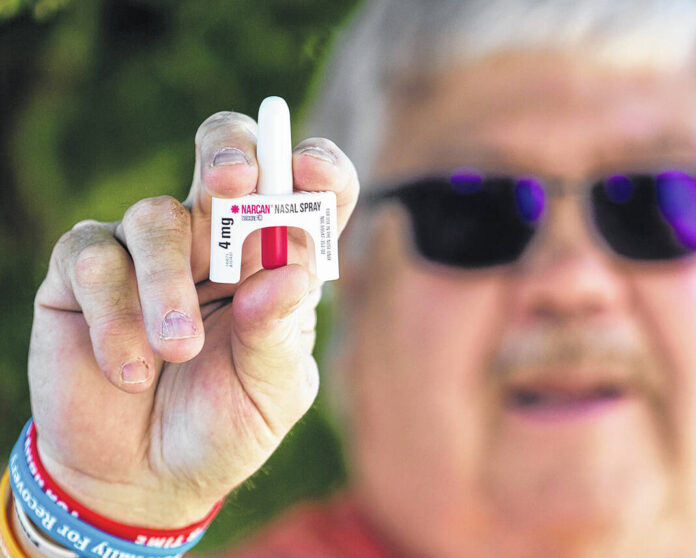
Shane Manson of Families of Addicts, a non-profit that offers support to families and friends with loved ones who are addicts, holds up Narcan nasal spray. The overdose reversal kits were distributed to the public Friday outside Vibe Coffeehouse as part of a recovery fair.
Photos by Emily McBride | The Lima News
LIMA — Public health officials are ramping up efforts to get naloxone into the community amid an uptick in overdose fatalities, which have become more prevalent here since the start of the coronavirus pandemic.
Allen County alone has recorded 75 suspected overdose fatalities since 2020, Ohio Department of Health data show. The trend upends years of progress recovery advocates had made toward reducing overdose fatalities through a combination of harm reduction and treatment.
To reduce fatalities, Allen County Public Health and recovery groups on Friday distributed free naloxone kits to the public in the parking lot outside Vibe Coffeehouse, the second public distribution effort the health department has made in as many weeks.
“I want to get Narcan in the hands of as many people as humanly possible,” said Shane Mason, a certified naloxone demonstrator and co-director of the Families of Addicts chapter in Van Wert, who started carrying naloxone after his daughter was revived from an overdose years ago.
The health department has offered the nasal spray kits, which temporarily block the effects of opioids to reverse an overdose, to the public for years.
Most of the kits have been provided to friends and family members of a person at risk of overdosing, said Tami Gough, a public health educator and former Project DAWN administrator for ACPH. But getting naloxone to people in active addiction has proved more challenging, Gough said.
“I like to compare it to AEDs, the defibrillators that a lot of people put in their business so it is available wherever these people may be,” Gough said.
To reach those at highest risk of overdosing, the health department works with outpatient treatment centers, recovery services and emergency departments to offer naloxone to anyone with a history of substance-use disorder.
The Ohio Department of Health has similarly revised its online portal for those searching for naloxone, simplifying the process of obtaining the nasal kits for anyone who wants them.
“The unfortunate thing is we hear from patients is that: ‘Well I used last time and was OK and all of a sudden it’s not now, so what’s different?’ And really there’s no way to know what may be in the specific drug a patient or person may be using—what the adulterant is, what the dosing is,” said Dr. Alexander Bovrov, emergency department medical director for Mercy Health-St. Rita’s Medical Center.
Bovrov suggested a few harm reduction strategies for those who choose to use illicit drugs: Never use alone and be cautious when using illicit drugs that may be tainted with potent adulterants like fentanyl.
“Alcohol is legal but people take your keys so you can’t drive,” Gough said. “Opiates aren’t legal, but we know they’re used. Having a Narcan kit available doesn’t condone it and doesn’t encourage it. It’s just there if we need the harm reduction tool.”
Where to find naloxone






